What is buckwheat and what kind does it look like when it grows in the field
Buckwheat porridge is a taste familiar from childhood. Buckwheat is grown in Russia by many farmers, since groats are very popular. Abroad, it is considered organic food. In sprouted form, it is often consumed by raw foodists.
If someone at least once sees how buckwheat grows and blooms, he will never be able to forget this sight. The green carpet, strewn with flowers, exudes an intoxicating aroma, and bees fly over it to collect nectar and turn it into useful honey.
The content of the article
What is this plant
Sowing buckwheat (Fagopýrum esculéntum)Is a herbaceous annual plant from the genus Buckwheat (Fagopyrum), melliferous and grain, also refers to pseudo-grains (Pseudocereal). FROMPeople and songbirds feed on them.
The homeland of this culture is North India and Nepal, although it has a different name there - black rice. Wild buckwheat can be seen in the Himalayas. About 5 thousand years ago, buckwheat was introduced into culture.
In Altai, they found ancient evidence that buckwheat porridge was used by people for food. Also, in places where there are burials or trade routes, fossilized buckwheat grains were found.
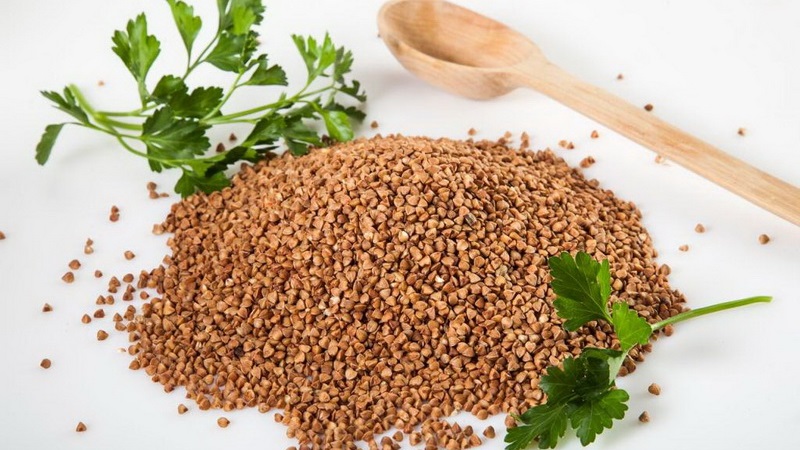
The Great Silk Road contributed to the spread of culture in many countries. There is a version that the plant got to Europe thanks to the Tatar-Mongols. In the 7th century, they learned about him in Byzantium, and then in Greece. Buckwheat is mentioned in the Lay of Igor's Host.
In Japan and China, buckwheat is used to give flour a color or smell. In Europe it was called "pagan grain" and "beech wheat".
The healing properties of buckwheat honey have been known since ancient times. Vitamin infusions are obtained from leaves and flowers. Groats are recognized by doctors as ideal for patients with diabetes mellitus. It is also recommended by nutritionists for those who want to lose weight. It is believed that buckwheat is a national Russian dish.
The plant is undemanding to the soil. Buckwheat itself fights weeds, displacing and killing them in the very first sowing year. The second field is already clean without pesticides, which has a positive effect on the environment.
What family does buckwheat belong to?
Sowing buckwheat belongs to the Buckwheat family (Polygonaceae), it has several types. On the European part of Russia, there are only 2 species: cultural and Tatar. For industrial production, the first is used.
The second is also called kyrlyk. It is resistant to low temperatures, the fruits are thick-skinned. Goes to feed for livestock. It is grown as a green manure. It grows in the wild in Siberia.
What it looks like in nature
The flowering fields sown with buckwheat are very beautiful. It is not for nothing that many artists depicted such landscapes, for example, Borisov N.A.At first it is just greenery, but then flowers appear, bees fly to their smell, and the landscape becomes truly magnificent.
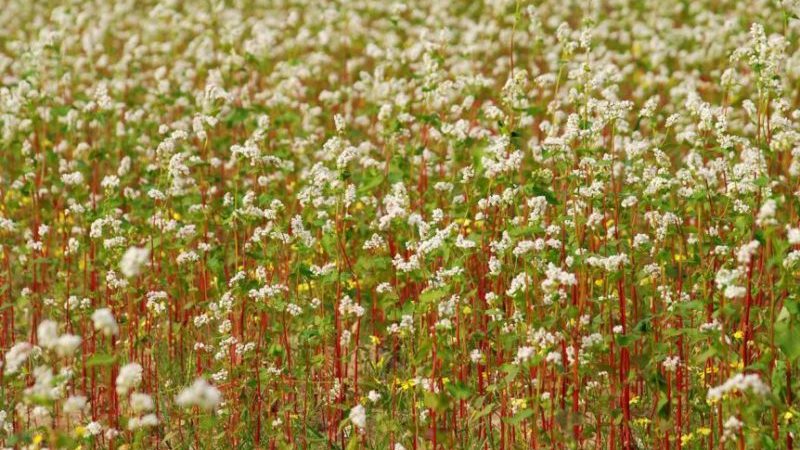
During flowering
When blooming, small flowers appear, white or pink. They are very fragrant, which attracts bees. The stem is erect, not pubescent. As it ripens, it becomes intensely red. The leaves are in the form of a heart, they have the shape of a triangle, the color is partially green. Petiolar below, sessile above.
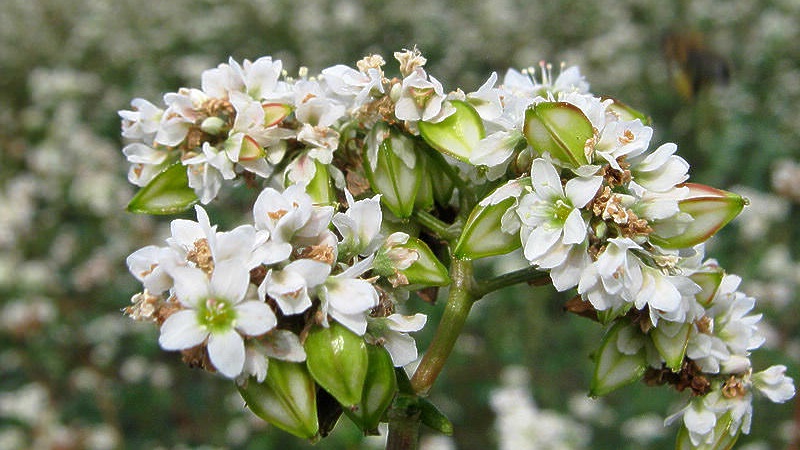
The flowers have 5 petals, shades of pink, the inflorescence is collected in a brush. One inflorescence contains from 600 to 2000 flowers. They are bisexual. For buckwheat, sexual dimorphism is characteristic, when the columns and stamens of the same flower differ significantly in height.
Formation and development are observed simultaneously: both buds and fruits.
Attention! Buckwheat blooms up to 2 months. The peduncle is very delicate and easily damaged by frost. He is also the first to suffer from drought.
Before harvest
In late summer or early autumn, the bunch turns into a fruit that looks like a small nut with 3 sharply outlined edges. The color of the fruit is light gray to dark brown and even black. The fruits themselves are divided into winged and wingless; there are also intermediate ones, they are covered with husks.
In the photo - buckwheat.
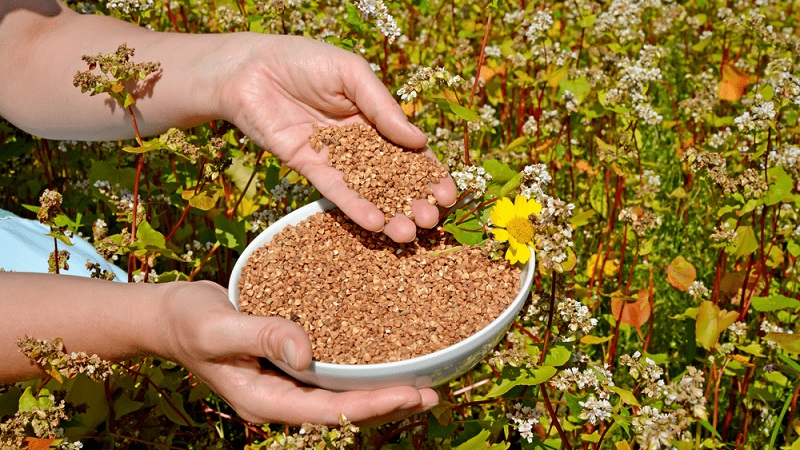
How buckwheat grows in the field
Buckwheat is sensitive to air temperature. Large differences have a detrimental effect, so they try to avoid frost, waiting for stable positive values. In order for the seeds to germinate, the soil layer is allowed to warm up, and the air temperature to rise to + 8 ° C. Optimum indicators for vegetation are + 15 ° C, flowering - + 25 ° C. At higher temperatures, pollination is impaired and the ovaries die off.
For the field, a site with good lighting is selected, next to the forest, so that it obscures the crops from strong winds. If there is a reservoir nearby, the harvest is rich and of high quality.
Usually, hives are placed around the perimeter of the field, since buckwheat is a honey plant. Bees pollinate plants and can increase yields by 50%.
If the weather is favorable, seedlings appear 6-7 days after sowing. During the next week, the first leaf is formed, after 12 days - the second. At the same time, branches form in the axils of the leaves, and buds - buds - appear on their tops.
Reference. The flowering period depends on the variety: early ripening - 3 weeks after germination, late ripening - in a month.
One flower blooms for a day, a brush for two months. The fertilized ovary grows and after 8 days it reaches its normal size, and after 10 days it fully ripens. Flowering and fruit formation are extended periods. The “nuts” at the bottom begin to ripen, then the process goes up, so the grains on the lower tier will be more full.
Plant height is different, minimum 15 cm, maximum 70-120 cm. The root system of buckwheat is pivotal, poorly developed, deepens by 40 cm, there are numerous processes on the sides. The stem itself is as hollow as a reed. If buckwheat is young, the stem is green, and as it grows, it acquires a reddish-green tint and then turns red completely.
The upper part of the plant is responsible for the assimilation of the necessary components from the soil, the lower one for water supply. In this case, the root system develops while the growth period continues.
Buckwheat ripens unevenly: the upper grains are not ripe, the flowers are still visible, but below they are already ripe and even have time to crumble. Harvesting is done after 2/3 of the fruits are brown. Delays are fraught with large crop losses.
How buckwheat grows can be seen in the photo.
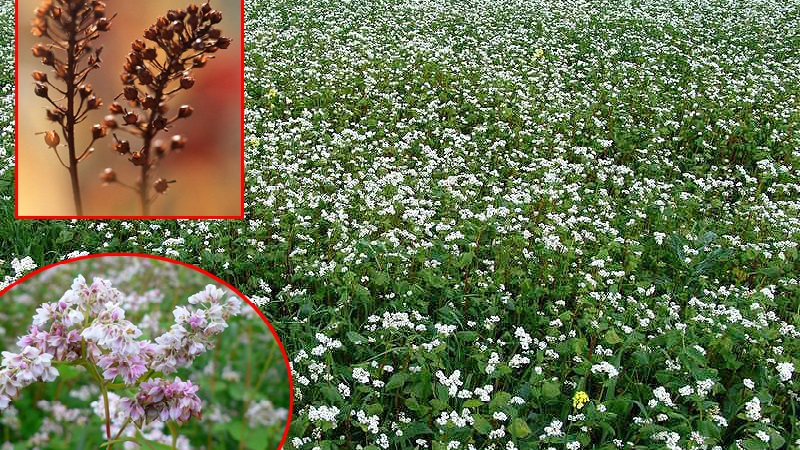
Read also:
How to eat buckwheat for type 1 diabetes
Is it possible to eat buckwheat with type 2 diabetes
How to eat buckwheat in case of poisoning and can it cause it
Conclusion
Buckwheat has gone through almost all development steps with humanity and today it never ceases to delight people with its nutritious and healing properties. In Russia, this is the most popular cereal. In Japan and Korea, flour is made from it. In Europe, buckwheat that has not undergone heat treatment is sold in pharmacies, and brown buckwheat is sold in pet stores as feed for livestock.